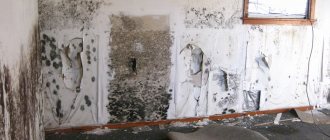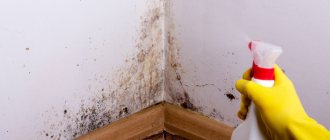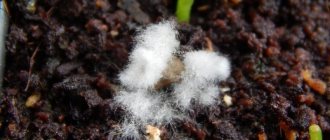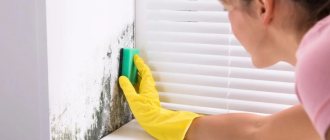- April 1, 2019
- Walls
- Ksenia Yedikhanova
Most people have at least once encountered the problem of black mold on the walls of their home. It consists of small black specks that no one pays attention to and simply erases them. Unfortunately, it soon begins to grow and become larger in size. How to get rid of black mold on the walls of an apartment? Effective methods and nuances are described in the article.
Habitat
Where is black mold most likely to appear? She, like all fungi, needs a nutrient medium. The most suitable conditions for its life are damp places. For example, if there is a problem with leaking pipes in the bathroom, then there is a high probability of dark spots forming on the walls.
In addition, black mold can be found anywhere - in the refrigerator, near ventilation grilles, vents, on bread, fabric, under the sink, bathtub, at the joints of tiles, in places where the shower stall or bathtub touches the walls.
The main condition for the existence of black mold is high humidity. It can feed on both organic and inorganic products, such as glue and wallpaper.
Industrial products for combating mold
The modern chemical industry offers many effective detergents and disinfectants. There are special sprays, gels and powders to combat fungus.
The most popular on the market are:
- Liquid antiseptic Dali - suitable for all types of surfaces. They can be used to treat indoor walls and rehabilitate external outbuildings, basements and attics.
- Fongifluid alpa is a deep-penetrating liquid product that is excellent for both killing mold and preventing its proliferation.
- Liquid fungicide Olympus.
- Biotol spray is intended for anti-mold treatment of rooms with high humidity: kitchens, bathrooms, swimming pools, saunas, baths, laundries, food production facilities.
- Mavix-bio is a complex fungicidal agent. Treatment is carried out in three stages: impregnation, washing and hydrophobization of the surface.
Causes
How to get rid of black mold in an apartment? To do this, you need to eliminate the main causes of its occurrence. As stated earlier, the optimal habitat for mold is high humidity in the home, which, in turn, is provoked by the following reasons:
- poor ventilation;
- dampness in the basement;
- walls that freeze in winter;
- a large number of plants that require frequent spraying;
- constant drying of large amounts of laundry in the living room;
- poor insulation of inter-wall seams and cracks;
- insufficient heating of the home.
Mold can also appear if there are cracks in the house through which moisture enters from the outside and destroys the wall from the inside. If mold gets inside such a crack, getting rid of it can be problematic.
Causes and signs of mold
To get rid of mold once and for all, it is enough to clearly determine the cause of its appearance in your apartment and eliminate it. The fact is that fungal spores are present in any room, but the basis for their development is favorable conditions, which become the reasons for the appearance of moldy spots in different parts of your home :
high humidity combined with poor ventilation, which often happens in the kitchen or bathroom, in apartments on the first floors, houses where humidification is abused, etc.;- freezing of walls;
- ground dampness;
- leaking water pipes;
- roof leaks;
- poorly heated room.
Everyone has probably already encountered the phenomenon of mold and can easily recognize it: it is the appearance of an unpleasant damp smell, spots of black, gray or white. To get rid of mold forever, you need to apply a set of measures, and in addition to the means described below aimed at combating already existing fungus, be sure to eliminate the cause of its appearance.
In general, all work to combat mold in the house comes down to the following list of measures:
- clean the affected surface from mold;
- treat the surface with a mold repellent;
- Throw away all items severely damaged by fungus;
- create normal conditions in the room: good ventilation, normal heating, eliminate all sources of high humidity.
At the moment, a lot of anti-mold remedies have been invented, each of them is applicable in certain conditions and differs in some features.
Types of mold
In order to know how to remove black mold, you need to decide on its type. The general name usually refers to several of the most common types of molds:
- Aspergillus black is a fungus that loves high humidity. This is what appears in the bathroom, kitchen or even in the air conditioner. Most often it attacks the seams between tiles in the bathroom or toilet.
- Aspergillus fuming, the peculiarity of which is that it can easily withstand temperatures up to 53 degrees, and is therefore resistant to high temperatures in the bathroom.
- Alternaria alternata is a black fungus that attacks fabric and food, as well as wood.
These mold spores are equally dangerous to both humans and pets, so if they appear, you should get rid of them as soon as possible.
Harm and types of mold
Mold often appears in our homes, which can be of several types:
- White mold usually appears in flower pots as a reaction to excessive moisture or the use of certain fertilizers. Human exposure may manifest as an allergy;
- green mold can appear on food: eating contaminated food risks causing serious illness. Green mold also occasionally affects building materials, such as brick;
- black mold is enemy number 1. This is the most common type of mold and can affect any surface: wallpaper, paint, plaster, boards, concrete, etc. If left untreated, it can subsequently cause insomnia, dizziness, fever, headaches, and in the worst case, asthma, bronchitis, dermatitis, pneumonia and even lung cancer;
often appears on wooden surfaces in the house: parquet, frames, furniture, etc. They begin to acquire an unpleasant dull blue tint, the paint layer is destroyed, and even the paint coating cannot save it;
blue mold- Rotting mold is another enemy of wood. Depending on certain features, the tree may acquire a gray or brown tint, become lighter, cracks appear on it, etc.
None of the finishing materials known to us can resist mold. But in addition to harming repairs, it is also toxic to the human body , especially children. Depending on the level of mold spread in the apartment, the symptoms may be different: first there is an impact on the respiratory system, and then on the entire body as a whole. Evidence of the negative impact of the fungus is the appearance of a cough, runny nose, lack of air, difficult to diagnose chronic diseases - all this is the reason for being in a damp room contaminated with mold.
Mold can also cause nausea, vomiting, headaches, and fatigue. In addition to the fact that it looks unaesthetic, it also has a destructive effect on building materials: it penetrates the structure, quickly spreads and occupies more and more areas. That is why, after detecting even hints of mold, it must be eliminated immediately.
What is the danger?
At first glance, mold may seem unpleasant but harmless, but this is not the case. Black mold can cause serious harm to humans, including death. If you live near mold fungi for a long time, the following health problems may appear:
- Dermatitis and other skin diseases, the nature of which is difficult to determine, which means they are difficult to treat.
- Diseases of the respiratory system, such as asthma, bronchitis, pneumonia.
- Diseases of the musculoskeletal system, as mold spores negatively affect human joints.
- Allergic reactions up to Quincke's edema.
- Once inside the body, black mold can cause disorders in the functioning of internal organs, especially the stomach and intestines.
When living for a long time in a home with mold, a person becomes irritable, prone to depression, weakness in the body, and frequent headaches. With a high concentration of spores of the fungus of the genus Aspergillus, intoxication of the body can occur.
Elderly people and young children are most vulnerable to mold because their immune systems are not strong enough to fight mold spores on their own.
The importance of air circulation
Mold, as well as the substances used to kill it, can irritate the eyes, skin and lungs. Therefore, before starting work, it is necessary to ensure a sufficient supply of fresh air. In the room in which the fungus will be destroyed, if possible, you should open all the windows. A similar rule applies to winter: you need to open at least one or two windows to let in fresh air.
To help fungal spores leave the room as quickly as possible, you need to turn on the fans, creating a flow of air that goes outside the room.
To do this, place the fan near an open window so that the air stream is directed towards the street. Mold spores will escape with the air. To prevent mold spores from spreading throughout your home, do not turn on fans when they are not near a window or directed outward.
When cleaning the walls of an apartment from mold, it is necessary to close the ventilation openings and doors connecting the room with other rooms to prevent fungal spores from entering there. However, sealing does not guarantee that black mold will not begin to grow in another area. Since fungal spores are constantly present in the air, mold can appear in any damp place.
First signs
Before you remove black mold from walls or other surfaces, you need to find it. Most often, the first spots of mold can be found in the following places:
- on tiles and joints;
- in places where the bathtub comes into contact with the walls;
- in the corners of the room.
First, small spots of a brown or greenish tint appear, which then grow into large colonies of mold fungi. Also, a specific musty smell appears in the room, by which you can unmistakably determine the presence of mold in the house.
Method 3 – removal of black mold in mass quantities
- If the surface is deformed or has a strong damp smell, then most likely there will be mold there. This could be under the bathtub or sink. Between plasterboard walls or in doorways. Mold also often appears on the ceiling, as warm air rises to the top.
- If the scale of the affected surface is large and the losses are huge, then it is easier to completely replace the element. Such problem areas may include tiles, carpet, floorboards, and suspended ceilings.
- Before replacing or cleaning, seal all holes and cracks with plastic. This is necessary to prevent disputes from getting into other rooms. Leave only ventilation openings that do not lead into rooms.
- Be sure to wear protection. Goggles, respirator, overalls (or just old clothes that you don’t mind throwing away), gloves.
- Be sure to pack everything you remove and seal it with tape. Wrap affected trim pieces in trash bags. Under no circumstances should black mold spores be allowed to spread.
- If the area is huge, then you will need the help of a professional service.
- It's all about humidity, so in addition to removing mold, you also need to fix the indoor climate. It could be poor ventilation or leaking pipes. Maybe the mold is coming from the basement or attic. You need to examine everything and fix it.
Adviсe
Contact our cleaning company.
Black mold is dangerous, especially for people with allergies or respiratory problems. And so it is the causative agent of such diseases. Monitor your health and as soon as you discover mold, destroy it immediately and ruthlessly.
Folk remedies
How to eliminate mold on the walls in an apartment? In the event that the fungi have not yet managed to form a large colony and look like individual small spots, folk remedies that have been proven over the years can cope with them:
- Medical ethyl alcohol 96%. Directions for use: Apply a small amount of alcohol to a sponge and wipe the fungus-affected areas. To enhance the positive effect, it can be mixed with ammonia and glycerin; this composition is applied to the affected areas for half an hour and then washed off with water. This method works well for tiled or plastic surfaces.
- Baking soda. Directions for use: a few tablespoons of ordinary baking soda should be dissolved in water, and the resulting solution should be sprayed onto the fungal affected areas. After this, use the hard side of a sponge with a small amount of citric acid to thoroughly rub the areas where fungi have formed.
- On horizontal planes, it is convenient to use the following method: pour a small amount of soda onto the contaminated surface, and then pour 9% table vinegar on top. The reaction that occurs between them will help get rid of mold quickly.
- Copper sulfate. How to get rid of mold in the house on the walls with its help? To do this, you need to dilute 10 g of the substance in 1 liter of water and apply it to the affected surface using a spray bottle.
- For mild damage, you can use tea tree essential oil. It must be mixed with salt, a small amount of water, and then applied in a thin layer to the area affected by the fungus.
Numerous reviews also report that mold can also be removed using hydrogen peroxide, which needs to be sprayed on a colony of harmful fungi.
Where does it appear?
Aspergillus is a fairly unpretentious resident, which makes it almost ubiquitous. However, there are surfaces on which the appearance and active proliferation of fungus is most likely. There are several of them.
- Plastic. PVC windows store heat, have a high degree of sound insulation and at the same time are excellent for the life of black mold (moisture does not evaporate).
If PVC windows are constantly closed, the appearance of fungus cannot be avoided - Drywall. The material is convenient and popular in construction, but it absorbs moisture, which does not evaporate. It is important to follow the installation technology here: slabs that are not completely dried will become a source of mold.
Mold on drywall - Concrete. Most often these are floors (floors, walls). If designers or builders make mistakes, the joints between walls, especially corners, are exposed to precipitation and cold.
Mold on the walls - Technique. These are appliances that come into contact with moisture: refrigerator, washing machine, split system/air conditioner, air humidifiers. If these devices are used incorrectly, there is a possibility that black mold will settle there too. It is advisable to keep the equipment dry; wipe wet parts often.
Mold in the washing machine - Wardrobe items. This will happen if the laundry is stored in sealed boxes or damp cabinets. Most often, we simply break the rule of dryness: under no circumstances should we put away things that are not completely dried!
Fungus can even appear on clothes
Chemicals
How to remove mold on the walls in an apartment? There are several methods available:
- You need to take any bleach that contains chlorine, pour it into a spray bottle and generously spray all affected areas.
- Ammonia and water should be diluted in equal quantities. The composition is applied to the mold colony, and then, after 2 hours, washed off.
- Using chlorine powder is also quite effective. It must be diluted with water according to the instructions, and then applied to the mold. This product is very toxic, so its use is only possible if a protective respirator and gloves are used.
How to get rid of mold on the wall? Reviews often recommend using the drug "Furacilin", which is known for its antiseptic properties. To do this, you need to crush 10 tablets into powder and dissolve in a glass of water. Use the resulting liquid to spray the areas where molds grow. After some time, you need to clean off any remaining fungi with a stiff brush and re-treat the surface with an antiseptic. This product is yellow in color and also leaves marks, so it is recommended to use it only on tiled or plastic surfaces.
How to choose a remedy for mold on walls
Mold on the walls of an apartment often occurs where there is high humidity. There are a lot of offers on the household chemicals market, but what to choose and buy from this is a difficult question. When getting acquainted with products, we recommend taking into account several criteria: degree of mold contamination, composition, reviews.
Degree of mold damage
Before choosing one of the names presented, think about the scale of the problem. The stronger the contamination, the “deeper” the fungus has eaten into the walls, the higher the concentration of active substances should be: surfactants, chlorine, solvents. You may have to fight several times until the stains are completely removed.
Compound
All presented candidates are based on surfactants, chlorine, and acids. Therefore, when working with them, protection from strong odors is required in the form of a respiratory mask. Flavoring is added to modern drugs to at least somehow compensate for this deficiency.
Reviews
It is difficult to determine in advance how well the product you are considering will cope with contaminated areas. We recommend that you first read the reviews of those who already have experience in dealing with mold. Various resources have collected many reviews with photographic evidence of how quickly and accurately mold can be removed.
Professional products
How to get rid of black mold on walls yourself? If folk remedies for fungi do not bring the expected positive effect, then you should pay attention to professional remedies. They will cost a little more than using simple soda or vinegar, but manufacturers promise 100% results. Among the most popular means are the following:
- Anlas Mykos is a powerful and effective remedy that can help get rid of even outdated and overgrown mold colonies.
- Profilux is a drug that has an effective effect on mold that has affected wooden surfaces.
- “Antisept” is a Russian-made product that is widely used for antiseptic preventive treatment of surfaces at the repair stage.
- Schimmel Vernichter helps eliminate mold on all types of surfaces. It is highly effective against most known varieties of fungi.
Since professional mold removal products are highly concentrated, it is recommended to use protective equipment such as a respirator and rubber gloves.
How to remove fungus in an apartment using specialized means
Depending on the area affected and the complexity of the surface being treated, the market offers professional methods of combating black mold. The most popular are imported products.
Senezh Effo
A good option for porous materials, tiles and other hard surfaces . The liquid is economical in consumption.
Does not leave stains, self-neutralizes, suitable for processing food containers. On delicate materials it is recommended to dilute the product in a 1:1 ratio.
In other cases, the drug is applied to the area affected by the fungus using a sponge or brush. On vertical surfaces, processing is carried out from bottom to top.
The action of Senezh Effo takes place in the first 2-3 hours . Next, dry the surface naturally. If necessary, the treatment is repeated until the problem is completely eliminated.
If the treated area is designated for painting, the manufacturer recommends washing off the composition after 24 hours or waiting 10 days and painting.
Depending on the volume the price is as follows:
- 5 kg - about 500 rubles;
- 10 kg – approximately 900 rub.
Fongifluid (ALPA)
Suitable for use on external and internal areas infected with fungal spores. Nominal volume 2 l. Economical to use.
Suitable for porous and smooth surfaces. When used on paint and varnish surfaces, it increases their resistance to moisture. Leaves no traces. It does not have a pungent odor, which provides an advantage for use in enclosed spaces .
Before application, the surface is prepared. The areas are cleaned with a spatula, a metal brush, and, if necessary, washed with water.
Instructions:
apply the composition using a roller or brush,- leave for activation for 4-6 days,
- after the allotted time, remove any remaining product with a stiff brush, rinse off the surface with water,
- Allow the treated area to dry.
The manufacturer guarantees protection against fungus for 2 years.
Available in quantities:
- 0.5 l. - about 500 rub.,
- 2 l. - about 830 rubles,
- 5 l. - approximately 1650 rub.
Homeenpoisto (TIKKURILA)
The most aggressive of the drugs presented . Processing should be carried out only in a respirator, goggles and rubber gloves.
Not for use on glass, aluminum surfaces or other delicate areas. Strictly incompatible with detergents.
Before treating unpainted wood surfaces, prime with any antiseptic. The Finnish manufacturer recommends Valtti Pohjuste.
Next, dilute the drug concentrate with water 1:3 and apply for 30 minutes. sponge or brush . If the result is not satisfactory, treatment is not stopped until the fungus completely disappears.
All this time, the surface is kept moist using the product. Upon completion of application, the surface is thoroughly washed with water from top to bottom. The price will be for 1 liter. about 550 rub.
Help from specialists
How to get rid of fungus on the wall in an apartment if all proven methods do not bring the desired effect? This is possible if walls infected with harmful fungus have porous surfaces or cracks. How to understand that you need help from competent specialists? The following factors may indicate this:
- The total area of the affected space exceeds 3 square meters. With such an extensive mold infestation, it is quite difficult to deal with them on your own.
- If mold has entered the ventilation system or air conditioner.
- Even with regular cleaning of small lesions, they grow at a fairly high rate.
- Molds appear as a result of extensive water or sewage flooding.
Experienced specialists have tools that allow sanitization even in the most difficult to reach places. These technologies can influence not only the external manifestations of the fungus, but also directly the mycelium.
TOP 5 drugs whose action is aimed at destroying fungal mold in the house
Domestos Universal
- The country producing the products is Italy .
- Release form: antifungal liquid in a bottle, served as a spray.
- Volume – 750 ml.
- Active components – surfactant anion (5%), sodium hypochloride .
- The peculiarity is that the smell is quite pungent, you need to wear a mask when working.
- The method of action of the drug is cleansing and protection from flying germs and microspores.
- Toxicity is low.
- Shelf life – 730 days (2 years and 0.7 months).
- Approximate cost – 201-230 rubles.
Review of Domestos:
Irina Aleksandrovna, Pushkino, Leningrad region. Once a week I always use this new product from Domestos. But the appearance of mold under the plumbing came as a surprise. She climbed up because of the dampness. I had to treat it with this spray every other day. There is no way to get there, you will have to break all the casing. But the spray treated everything perfectly. Now there are still some gray spots left where I couldn’t wipe them with a rag and brush, but they seem to have frozen. 3 months have already passed, and the stains on the floor and in the corner are still there and are not spreading further. Domestos is great for processing in places where it is difficult to reach with your hands.
SAVO
- Country of origin: Czech Republic .
- The form of the product is a spray, a liquid supplied from a bottle through a spray bottle.
- Volume – 500 ml.
- Active substances - surfactants or active surface substances (less than 5%), sodium hypochloride (4.7%).
- Targeted – kills mold from windows, ceilings, doors, walls, tiles and in hard-to-reach places on any surfaces.
- How to use - spray at a distance of 10 or 15 cm from the contaminated surface and leave for 15 - 20 minutes. Then rinse everything off with water.
- Warning - do not remove the mold before spraying the preparation so that the pores do not begin to spread through the air!
- Toxicity is average.
- Average price – 259-270 rubles .
Review of "Savo":
Anna, Minsk. The Savo product from the Czech brand works very well against mold. It’s generally easy to use - just spray it on the plaque and watch how everything discolors and disappears right before your eyes! Then everything is wiped with a brush and a rag and thrown into the trash. And for extra cleanliness, I went through the corners and walls with a vacuum cleaner. But my advice is, it’s better to leave the room after spraying - the smell is not very good, to be honest, it’s kind of chemical. We noticed a long-term effect - for six months now there has been nothing in that place. In a short time - an excellent result.
Pufas
- Country of origin: Germany .
- Product form: spray in a spray bottle.
- Volume – 1 l.
- The active component is active chlorine (sodium hypochloride solution).
- Where to buy - among building materials or through special sites on the Internet.
- Store 60 months (5 years).
- Toxicity is not high.
- The average price is 550 rubles.
Review of "Pufas":
Alexandra, Irkutsk. Pufas is an excellent product that simply helped us out when we were struggling with mold in the bathroom. Some ordinary cleaning with copper sulfate didn’t help, maybe it wasn’t diluted enough, I don’t know. But Pufas cleaned everything up very quickly.
White
- The country producing the products is Russia, the best manufacturer is considered to be LLC ChZBH "Vizir Company", Chelyabinsk .
- Form – liquid concentrate for ready use.
- Volume – 1 l.
- Active substance – sodium hypochloride (bleach) – 4% and 7%.
- Warning - do not apply to dyed fabrics and surfaces, it bleaches strongly!
- The average price is 30-55 rubles .
Review of “Whiteness”:
Antonina, Yekaterinburg. Oh, and I wash my clothes with “Whiteness”, do the cleaning once a week, wiping everything with it. An excellent tool, one might even say universal. Just don’t let it drip onto the upholstery of the upholstered furniture – I already ruined my chair like that once. And the product is very good! I recently had a chance to use it to treat a ceiling and a corner in a damp room. We removed the causes of the mold, and now we set about repairing it, but before renovating the room, it was necessary to remove the mold so that it would not grow further. They threw out all the old wallpaper, sprayed it with white from a regular spray bottle, let it sit for 3-4 hours, and then washed everything with plain water. Then we dried the room, ventilated it, treated everything with a primer and did a little plastering here and there. Again everything was allowed to dry. And then they put up the wallpaper. There has been no mold there for almost a year now.
Biotol
- Country of origin: Etonia .
- Form – liquid concentrate spray.
- Volume – 0.5 l.
- Active inclusions in the composition are biocide, benzalkonium chloride (4.5%).
- Toxicity is low, but contact with mucous membranes, mouth or eyes should not be allowed. Keep away from children.
- Approximate price – 300 rubles .
Review of "Biotol":
Natasha, Tver. And we are in the basement, where we have a crate where we put all kinds of rubbish, like in a storage room, for the first time we tried to remove the mold with Biothol - it helped! After that, we started using it in the house - an excellent option to eliminate mold. True, in the bathroom, where the condition was too neglected, 3 treatments had to be done. Moreover, the drug is completely harmless to health.
How to remove odor
How to get rid of mold on the walls in an apartment? Using the folk and chemical remedies described above, you can effectively remove the source of mold damage. Despite this, the characteristic odor may remain. In order to get rid of it, you can try the following methods:
- It is important to thoroughly dry the area from which the mold was removed. This can be done using a hair dryer. This point especially applies to wooden surfaces, which absorb moisture and odors.
- Baking soda is known for its ability to absorb odors well, so you can sprinkle it on the areas where the fungus is spreading and rub it well with the rough side of a sponge.
- You can try mixing boric acid, which is known for its antiseptic properties, hydrogen peroxide, table vinegar and water in a ratio of 1:1:1:2. Treat the surface with the resulting mixture and leave for 2 hours, then rinse with plenty of water.
How to get rid of mold on the walls in an apartment and its smell? Prolonged ventilation and drying of the room also helps to remove the obsessive moldy smell.
Fighting unpleasant odor
Even after eliminating the outbreak of Aspergillus, the musty smell of mold may persist in the apartment. To combat it you can use:
- Essential oils with antiseptic properties (fir, pine, lemon, grapefruit, lavender, peppermint and others).
- Birch charcoal or special activated carbon cassettes.
- Dry soda, which can be sprinkled on the floor, furniture and carpet, and collected with a vacuum cleaner after a couple of hours.
- Forced ventilation during ventilation to enhance air flow. In the warm season, you can create drafts by opening windows and doors at the same time.
Other methods
How to get rid of black mold on walls? Reviews note that the following methods are also effective:
- A weak solution of potassium permanganate has excellent antiseptic properties. Unfortunately, potassium permanganate is difficult to find today, but many people still have old supplies.
- Grapefruit seed extract. You only need 10 drops per 1 glass of water. The resulting solution should be sprayed onto the affected areas. The extract not only destroys mold fungi, but also has a pleasant aroma.
- Lavender or rosemary oil has antiseptic properties. The method of application is similar to using grapefruit seed extract.
- Citric acid allows you to get rid of not only scale in the kettle, but also a small colony of mold fungi. To do this, you need to dilute the sachet with the substance in 1 glass of water, and then apply it to the affected areas using a sponge.
How to get rid of black mold on walls? In the fight against fungal infections, all means are good, since they are extremely dangerous to the life and health of the inhabitants of the home.
Safety rules when processing premises
When treating a room for mold, a respirator is required for safety reasons.
When carrying out mold removal work, it is necessary to ensure protection of the outer coverings:
- use a respirator to prevent fungal spores from entering the respiratory tract and avoid poisoning by chemical vapors;
- you need to work with gloves;
- If spray is used, safety glasses should be worn.
After finishing the treatment, it is recommended to throw away the used products. The room also needs to be prepared: small items (bottles, hygiene products, etc.) are taken out. Furniture and other large items can be left, but they should be covered with plastic. After application of the product is completed, the room is closed for 1-12 hours. Once the substance has been removed from the surfaces, it is better not to enter the room for several days.
Prevention
In order not to have to think about how to get rid of black mold on the walls, it is important to pay attention to the following preventive points:
- Eliminate leaks from pipes in a timely manner.
- Set up an apartment ventilation system.
- Regulate the number of indoor flowers, since their excess quantity provokes the appearance of high humidity in the apartment.
- Insulate the walls of the house and repair cracks, if any.
- Use a hood when preparing food, as this evaporates a fairly large amount of moisture.
- Do not overuse household humidifiers.
- Use the balcony to dry clothes.
It is also recommended to monitor the serviceability of the heating system, the integrity of the roof in the house and promptly get rid of the slightest manifestations of the fungus before its colony grows too large.
Why does Aspergillus nigra appear?
Now there are quite a few varieties of mold, although they all have the same causes.
So, the first place is occupied by poor ventilation: in rooms where the air stagnates, mold appears extremely quickly and multiplies just as quickly. As a rule, this occurs due to poor ventilation in the apartment in the bathroom and kitchen. Second place in the ranking of reasons is occupied by high humidity. As we already wrote in one of the articles, high levels of humidity in rooms contribute to the appearance of condensation. It is the latter that is an excellent environment for the proliferation of fungal bacteria and their rapid development. Again, this applies primarily to the bathroom and kitchen. This also often shows up in garages, basements and cellars.
The third place receives a sharp temperature change. This often happens in new houses, when the mixtures embedded in the walls have not yet dried completely. In this case, condensation also appears on the walls, which, as we found out, contributes to the development of mold at the junctions of the wall from the street to any other.










